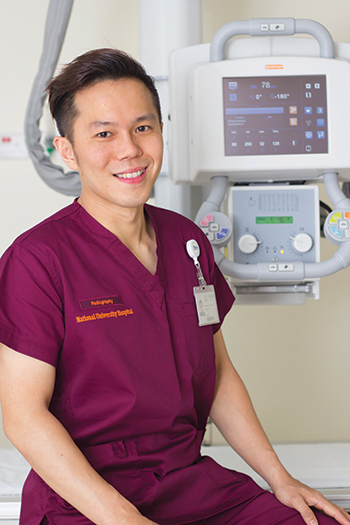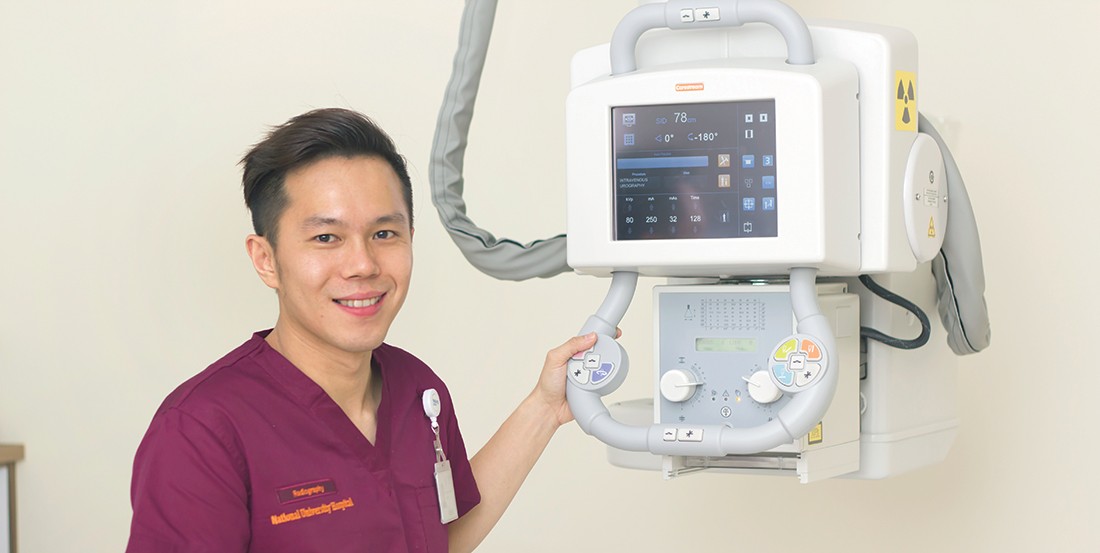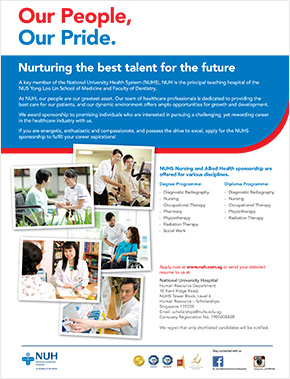R adiographers utilise state-of-the-art equipment to produce radiographic images of the body. These images then help the healthcare team diagnose illness or injury, paving the way towards a patient’s effective recovery.
This group of allied health professionals typically start their careers conducting general radiography – or X-rays – in the department of diagnostic imaging. As they progress, they will be assigned to perform radiological investigations in other areas such as the emergency medicine department, operating theatres, endoscopy centre, intensive care units, and general wards.
Experiencing the ups and downs of a Radiographer’s job is Healthcare Scholar Desmond Hoon. He tells us about the critical role he plays within the National University Hospital, which is part of the National University Health System (NUHS), and how he harnesses sophisticated technologies to determine his patients’ treatment.
What sparked your interest in the healthcare sector?
Desmond Hoon: As a child, I suffered from asthma and had to be hospitalised several times. Although I was just six years old then, I still vividly remember the care expressed by the hospital staff. They made my stay in hospital less frightening, and their professionalism played a major part in steering my career decision towards the healthcare sector.
As for Radiography in particular, I chose it because I saw it as a way to marry my personal interest in photography with my desire to make a difference in disease diagnosis and treatment.
What are your responsibilities as a radiographer?
Desmond: As a Magnetic Resonance Imaging (MRI) radiographer, my job is to ensure that any form of abnormality is demonstrated in the scans. To do this, I need to have a good understanding of the human anatomy and be able to adopt scanning techniques to different body types and conditions.

Desmond Hoon Hui Xiang
Healthcare Scholar
Designation:
Radiographer
Good communication skills are essential in my line of work. I make it a point to explain the scanning process to my patients, so that they feel less anxious throughout the procedure. Patients tend to be more cooperative when they are less nervous, allowing me to obtain radiographic images of better quality.
What are some challenges you face at work?
Desmond: One challenge I face at work is helping people understand my work. There are many misconceptions people have of diagnostic imaging. A lack of understanding leads to the fear of radiation exposure in the procedure, which people associate with nuclear disasters or cancer. As a trained medical specialist, I strive to educate patients and non-departmental co-workers about radiography, and the measures that are in place to prevent unnecessary exposure.
What are some memorable episodes you have had at work?
Desmond: I was once tasked to conduct a series of X-ray scans for a 13-year-old boy who was knocked down by a bus. He was in great pain, having sustained severe injuries to his lower extremities and abdomen. As I was the only staff in the X-ray room, he grabbed my arm and asked me if he was going to make it. It was heart-wrenching to see him in such a frightened and helpless state. I reassured him that we were going to do whatever we could to help him. This incident made me realise that my role as a diagnostic radiographer is not just to produce good radiographic images – but also to comfort patients who feel overwhelmed by their injuries or disease.
What would you say was most fulfilling about your job?
Desmond: The most fulfilling aspect of my job is being able to have a direct impact on a patient’s medical diagnosis. Doing my best to answer a wide spectrum of clinical questions through imaging also means that my work remains dynamic, challenging and meaningful.
What qualities should healthcare scholars possess?
Desmond: Passion, motivation and the drive for self-improvement. Medical science is always advancing, so a job in healthcare requires a commitment to lifelong learning. Patience and the ability to work in a team are also important qualities, because the hospital is a fast-paced and demanding work environment. You need to work closely with a diverse team of doctors, nurses, allied health professionals and ancillary staff in order for your work to be purposeful.
What else would you like to say to aspiring healthcare scholars?
Desmond: I learnt a lot through my scholarship, from solid theoretical knowledge set by my education to the experiences in my career. Make the most of your clinical attachment too, for this is when you are exposed to a real patient-care setting and where you can apply your knowledge to real-life practices. Last but not least, always be ready to seize your varied opportunities and take on challenges that are unique to the sector.

